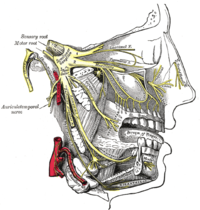
Photo from wikipedia
PURPOSE This study analyzes the risk factors associated with the incidences of inferior alveolar nerve (IAN) injury after surgical removal of impacted mandibular third molar (IMTM) and to evaluate the… Click to show full abstract
PURPOSE This study analyzes the risk factors associated with the incidences of inferior alveolar nerve (IAN) injury after surgical removal of impacted mandibular third molar (IMTM) and to evaluate the contribution of these risk factors to postoperative neurosensory deficits. MATERIALS AND METHODS An exhaustive literature search has been carried out in the COCHRANE library and PubMed electronic databases from January 1990 to March 2019 supplemented by manual searching to identify the related studies. 23 studies out of 693 articles from the initial search were finally included, which summed up a total of 26427 patients (44171 teeth). RESULTS Our results have been compared with other current available papers in the literature reviewed that obtained similar outcomes. Among 44171 IMTM extractions performed by various grades of operators, 1.20% developed transient IAN deficit and 0.28% developed permanent IAN deficit respectively. Depth of impaction (P<0.001), contact between mandibular canal (MC) and IMTM (P<0.001), surgical technique (P<0.001), intra-operative nerve exposure (P<0.001), and surgeon's experience (P<0.001) were statistically significant as contributing risk factors of IAN deficits. CONCLUSION Radiographic findings, such as depth of impaction, proximity of the tooth to the mandibular canal, surgical technique, intra-operative nerve exposure, and surgeon's experience were high risk factors of IAN deficit after surgical removal of IMTMs.
Journal Title: Journal of stomatology, oral and maxillofacial surgery
Year Published: 2019
Link to full text (if available)
Share on Social Media: Sign Up to like & get
recommendations!